|

|
 |
|
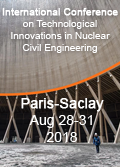 |
 |
|
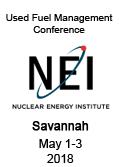
|
 |
|
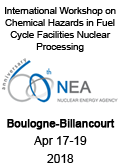
|
 |
|
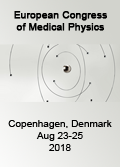
|
 |
| |
 |
| |
| |
|
|
|
|
Si no desea recibir mas este Boletín haga click aqui. |
|
|
|
|
|
|
|
|
|
|
|
|
|
|
|
 |
 |
 |
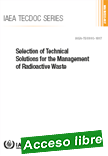 |
Selection of Technical Solutions for the Management of Radioactive Waste
IAEA TECDOC, 2017, 112 p.
The objectives of this publication are to identify and critically review the criteria to be considered while selecting waste management technologies; summarize, evaluate, rank and compare the different technical solutions; and offer a systematic approach for selecting the best matching solution. |
This publication covers the management of radioactive waste from all nuclear operations, including waste generated from research reactors, power reactors, and nuclear fuel cycle activities including high level waste (HLW) arising from reprocessing and spent nuclear fuel declared as waste (SFW), as well as low level waste (LLW) and intermediate level waste (ILW) arising from the production and use of radionuclides in industry, agriculture, medicine, education and research.
Extraído de: http://www-pub.iaea.org/books/IAEABooks/12217/Selection-of-Technical-Solutions-for-the-Management-of-Radioactive-Waste |
 |
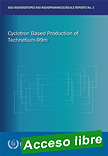 |
Cyclotron Based Production of Technetium-99m
IAEA Radioisotopes and Radiopharmaceuticals Reports, 2017, 59 p.
This publication presents a comprehensive overview of the technologies involved in the production of cyclotron based 99mTc. These would include techniques relevant to preparation of targets, irradiation of targets under high beam currents, target processing, target recovery and quality control of the final product. |
The publication provides broad information, well supported with references, on improved production routes and improved separation and purification of cyclotron based 99mTc. These approaches achieve high specific activity and chemical purity of 99mTc suitable for labelling molecules of medical interest and also enable spare capacity to be available at medical cyclotron centres. The readership of this publication is scientists interested in translating this technology to practice, technologists already working with cyclotrons wanting to enhance the utility of the existing machines and managers who are in the process of setting up facilities in their countries. Students working towards higher level degrees in related fields may also benefit from this publication.
Extraído de: http://www-pub.iaea.org/books/IAEABooks/10990/Cyclotron-Based-Production-of-Technetium-99m
|
 |
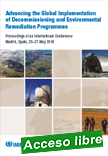 |
Advancing the Global Implementation of Decommissioning and Environmental Remediation Programmes - Proceedings of an International Conference Held in Madrid, Spain, 23–27 May 2016
IAEA Proceedings Series, 2017, 52 p..
These proceedings present the outcome of a conference on decommissioning and environmental remediation (D&ER) programmes, at which challenges, achievements and lessons learned in the implementation of such programmes during the past decade were shared and reviewed.
|
The decision to combine D&ER in one conference reflects the significant synergies that exist between the two activities; the conference aimed to explore those synergies to foster and optimize the implementation of D&ER worldwide. Key goals were to raise awareness of the importance of addressing the legacies from past activities, to identify current priority needs and to provide recommendations on the strategies and approaches that can enable and enhance safe, secure and cost effective implementation of national and international programmes in the future. The conference was organized around seven themes: National policies and strategies; regulatory framework and standards; decision making process; technical and technological aspects; waste management; project management; and international cooperation. The publication provides a detailed synthesis of the presentations made and the panel discussions which took place during the conference. The main ideas and messages expressed and discussed at the conference are presented in the President’s report, which is included in the publication.
Extraído de: http://www-pub.iaea.org/books/IAEABooks/11155/Advancing-the-Global-Implementation-of-Decommissioning-and-Environmental-Remediation-Programmes
|
 |
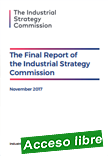 |
There is welcome and growing support for a new industrial strategy, but there is currently neither consensus nor clarity about what industrial strategy should entail or seek to achieve.
This report aims to redress this situation. Our recommendations seek to shape the design of a strategy and steer it towards a policy framework that can ensure future success.
|
Strategic economic management: Industrial strategy must be rethought of as a broad and non-partisan commitment to strategic management of the economy. It is a long-term plan, with a positive vision, to build on the economy’s many strengths and address its weaknesses.
New institutions are needed: Industrial strategy at the centre must be transformed. A new powerful industrial strategy division, within the Treasury, is needed to ensure all other departments devise and implement policies consistent with the industrial strategy.
Monitoring and measuring success: A new independent expert body should be created to monitor and measure the long-term success of the new strategy. On the model of the Office for Budgetary Responsibility, we propose the ‘Office for Strategic Economic Management’.
Outcomes: The new strategy should have an ambition to achieve positive outcomes and make material differences to people’s everyday lives.
Place matters: An industrial strategy should not try to do everything everywhere, but it should seek to do something for everywhere. In 5 or 10 years’ time we should be able to pick anywhere in the UK and say how the strategy has helped that place, its people and industries.
Further and faster devolution: Most places perform below the UK average, given the extent of centralisation; new approaches are needed. The strategy requires further and faster devolution to towns, cities and regions.
Universal Basic Infrastructure: All citizens in all places should be provided with Universal Basic Infrastructure. Everywhere in the UK should be served by high quality hard infrastructure and have access to high quality human capital-building universal services.
Health and social care: Achieving better outcomes for people’s wellbeing must be central to the strategy. New thinking can ensure health and social care aligns with industrial strategy.
Diffusion of innovation: World-class innovation happens in the UK but the effects should diffuse throughout the economy. We need to re-link excellence in basic and applied research.
New methods of appraisal: Decision-making for large strategic projects needs to be overhauled to better account for the potential impact on everyday behaviour. Cost-benefit analysis should apply to the real world, not just to a spreadsheet.
Choices: When there is a trade-off between economic efficiency and the equitable treatment of communities, sometimes it is right for the fairness objective to predominate.
A focus on the strategic goals of the state: The new strategy should be designed to meet the strategic goals of the UK. Our assessment is that these goals in 2017 are: Ensuring adequate investment in infrastructure; Decarbonisation of the energy economy; Developing a sustainable health and social care system; Unlocking long-term investment; Supporting high-value industries and building export capacity and Enabling growth in all parts of the UK.
Extraído de: http://industrialstrategycommission.org.uk/wp-content/uploads/2017/10/The-Final-Report-of-the-Industrial-Strategy-Commission.pdf
|
 |
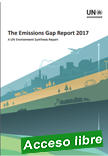 |
The Emissions Gap Report 2017 - A UN Environment Synthesis Report
United Nations Environment Programme (UNEP), November 2017, 116 p.
The eighth UN Environment Emissions Gap Report provides an up-to-date scientific assessment of the global progress towards the emissions reductions required to be on track to meet the long-term goal of the United Nations Framework Convention on Climate Change (UNFCCC). |
The overall conclusion of the assessment is that government and other stakeholder’s emissions reduction commitments are far from the level of ambition required for an emissions pathway consistent with staying below a 2°C, let alone a 1.5°C, temperature increase.
Extraído de: http://wedocs.unep.org/handle/20.500.11822/22070
|
 |
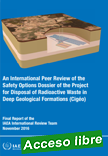
|
An International Peer Review of the Safety Options Dossier of the Project for Disposal of Radioactive Waste in Deep Geological Formations (Cigéo) - Final Report of the IAEA International Review Team: November 2016
IAEA Non-serial Publications, 2017, 43 p.
The French Nuclear Safety Authority (Autorité de sûreté nucléaire, ASN) is preparing the evaluation of a licence application for the creation of a deep geological disposal facility in 2018, called Cigéo, for intermediate level, high level and long lived radioactive waste. |
Extraído de: http://www-pub.iaea.org/MTCD/Publications/PDF/CIG_FRA_web.pdf
|
 |
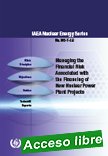 |
Managing the Financial Risk Associated with the Financing of New Nuclear Power Plant Projects
IAEA Nuclear Energy Series, 2017, 93 p.
Mitigation of the financial risks attendant on a nuclear power plant new build project is a key to ensuring project viability. This publication emphasizes how various risks — including those typically considered to be ‘engineering risks’ — will give rise to such financial risks.
|
It then introduces the linkage between efficient financial risk allocation/mitigation and the cost of capital, and sets out a range of mechanisms which can be used to manage and allocate risks efficiently, thereby minimizing the cost of capital and enhancing project economics. At a practical level the publication provides an insight into the concerns, modes of thinking, and language which a nuclear new-build proponent may expect to encounter within the financing community as they seek to develop their project.
Extraído de: http://www-pub.iaea.org/books/IAEABooks/11140/Managing-the-Financial-Risk-Associated-with-the-Financing-of-New-Nuclear-Power-Plant-Projects |
 |
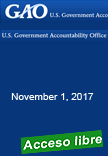 |
Low-Dose Radiation: Interagency Collaboration on Planning Research Could Improve Information on Health Effects
Government Accountability Office (GAO - US), November 1, 2017, 12 p.
The Department of Energy (DOE), Nuclear Regulatory Commission (NRC), Environmental Protection Agency (EPA), and Food and Drug Administration generally used the advice of scientific advisory bodies to develop and apply radiation protection requirements and guidance for workers and the public in the radiation exposure settings that GAO reviewed. |
These settings were: (1) the operation and decommissioning of nuclear power plants; (2) the cleanup of sites with radiological contamination; (3) the use of medical equipment that produces radiation; and (4) accidental or terrorism-related exposure to radiation. Specifically, the agencies relied on the advice of three scientific advisory bodies that supported the use of a model that assumes the risk of cancer increases with every incremental radiation exposure. Accordingly, the agencies have set regulatory dose limits and issued guidance to confine exposure to levels that reduce the risk of cancer, while recognizing that scientific uncertainties occur in estimating cancer risks from low-dose radiation. For example, NRC requires nuclear power plants to consider measures for limiting workers' exposure below NRC's regulatory dose limit, such as by using robots for maintenance work in radiation areas.
GAO identified seven federal agencies that funded research on low-dose radiation's health effects. In fiscal years 2012 to 2016, DOE, NRC, EPA, and four other federal agencies obligated about $210 million for such research (see table). Although the agencies have collaborated on individual projects on radiation's health effects, they have not established a collaborative mechanism to set research priorities. GAO's previous work has shown that federal agencies can use such mechanisms to implement interagency collaboration to develop and coordinate sound science policies. In the past, DOE took a leading role in this area because DOE provided stable funding and advocated for greater coordination on research on low-dose radiation's health effects. However, since fiscal year 2012, DOE has phased out funding for one of its main research programs in this area. This has created a void in coordination efforts among federal agencies, and no other agency has stepped forward to fill this void. Because of DOE's prior experience as a leader in this area of research and its research responsibility under the Atomic Energy Act of 1954, it could play an important role in helping federal agencies establish a coordinating mechanism for low-dose radiation research.
Extraído de: http://www.gao.gov/products/GAO-18-184T?utm_medium=email&utm_source=govdelivery
Highlights: http://www.gao.gov/products/GAO-18-184T?utm_medium=email&utm_source=govdelivery
Report: http://www.gao.gov/assets/690/688082.pdf
|
 |
|
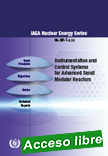
|
Instrumentation and Control Systems for Advanced Small Modular Reactors
IAEA Nuclear Energy Series, 2017, 95 p.
This publication emphasizes the key cross cutting technological issues associated with instrumentation and control systems and human system interfaces that arise from the specific behaviour and operational characteristics of advanced small modular reactors (SMRs).
|
It is intended to assist Member States in understanding current knowledge, practices, design and architecture, implementation, operating and maintenance related aspects with I&C systems in SRMs, as well as for discussing the challenges and issues that need to be resolved in this field in the first phases of design and implementation by Member States active in SMR development.
Extraído de: http://www-pub.iaea.org/books/IAEABooks/10960/Instrumentation-and-Control-Systems-for-Advanced-Small-Modular-Reactors
|
 |
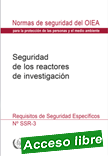 |
Seguridad de los Reactores de Investigación
Normas de Seguridad del OIEA, 2017, 164 p.
El principal objetivo de la presente publicación de Requisitos de Seguridad es establecer una base para la seguridad y la evaluación de la seguridad en todas las etapas de la vida útil de un reactor de investigación mediante el establecimiento de requisitos sobre los aspectos relacionados con la supervisión reglamentaria,
|
. la gestión en pro de la seguridad, la evaluación de un emplazamiento4, el diseño, la fabricación, la construcción, la puesta en servicio, la explotación —incluidas la utilización y modificación— y la planificación de la clausura.
Los requisitos técnicos y administrativos para la seguridad de los reactores de investigación se establecen con arreglo a estos objetivos. La presente publicación está dirigida a las entidades que participan en el diseño, fabricación, construcción, explotación, modificación, mantenimiento y clausura de los reactores de investigación, en el análisis, verificación y examen de la seguridad y en la prestación de apoyo técnico, así como también a los órganos reguladores.
Extraído de: http://www-pub.iaea.org/MTCD/Publications/PDF/PUB1751_S_web.pdf
|
 |
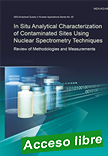 |
In Situ Analytical Characterization of Contaminated Sites Using Nuclear Spectrometry Techniques - Review of Methodologies and Measurements
IAEA Analytical Quality in Nuclear Applications Series, 2017, 204 p.
Past and current human activities can result in the contamination of sites by radionuclides and heavy metals. The sources of contamination are various. The most important sources for radionuclide release include global fallout from nuclear testing, nuclear and radiological accidents, waste production from nuclear facilities, and activities involving naturally occurring radioactive material (NORM).
|
Contamination of the environment by heavy metals mainly originates from industrial applications and mineralogical background concentration.
Contamination of sites by radionuclides and heavy metals can present a risk to people and the environment. Therefore, the estimation of the contamination level and the identification of the source constitute important information for the national authorities with the responsibility to protect people and the environment from adverse health effects.
In situ analytical techniques based on nuclear spectrometry are important tools for the characterization of contaminated sites. Much progress has been made in the design and implementation of portable systems for efficient and effective monitoring of radioactivity and heavy metals in the environment directly on-site. Accordingly, the IAEA organized a Technical Meeting to review the current status and trends of various applications of in situ nuclear spectrometry techniques for analytical characterization of contaminated sites and to support Member States in their national environmental monitoring programmes applying portable instrumentation.
This publication represents a comprehensive review of the in situ gamma ray spectrometry and field portable X ray fluorescence analysis techniques for the characterization of contaminated sites. It includes papers on the use of these techniques, which provide useful background information for conducting similar studies, in the following Member States: Argentina, Australia, Brazil, Czech Republic, Egypt, France, Greece, Hungary, Italy, Lithuania, Montenegro, Spain, United States of America and Uruguay.
Extraído de:http://www-pub.iaea.org/MTCD/Publications/PDF/AQ-49_web.pdf
|

|
|
|
| |
|
|
| |
| |
|
|
| |
| |
|
|
| |
| |
|
|
|
|
|
|
|
